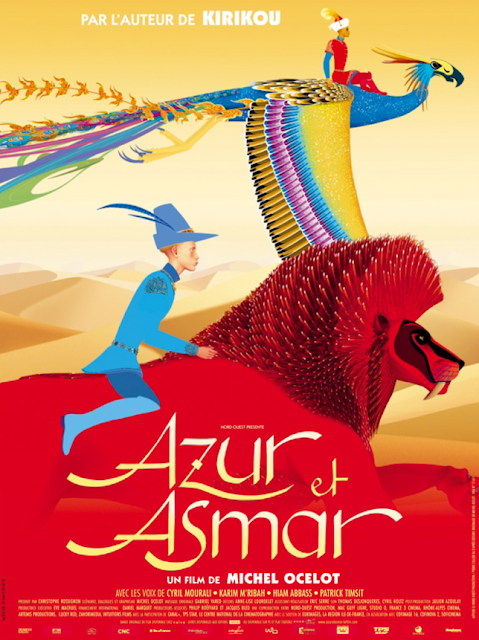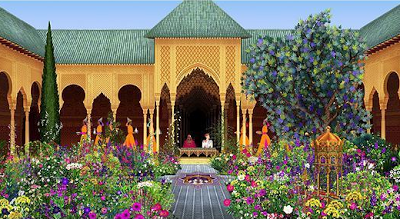 |
| French poster artwork for the animated French film Azur and Asmar. |
Brotherly Love by Linh
Writer and director Michel Ocelot has
created a sumptuous feast for the eyes in his first 3D animated feature film Azur and Asmar. Ocelot is better
known for writing and directing his animated films Kirikou and The
Sorceress, and has deliberately used 3D for the characters and 2D for the
backgrounds to create a cartoon-like appearance rather than a mimic of reality
for Azur and Asmar.
The result is a visually stunning family
animated film with enchanting characters that are inspired by the Arabian Nights and
Sinbad adventures. The film not only includes swashbuckling action on horseback
and mythical creatures, but also a
message of peace and acceptance between the Middle East and the West.
In an interview for 'The List' (issue 595),
Michel Ocelot explains his message of racial acceptance in his film Azur and
Asmar as being part of his response to the current War on Terror: "I
was thinking about the current political situation in the world even though the
story takes place a few centuries ago. People think that this idea for the film
was conceived after 9/11 but no, the genesis of the film started before that.
We saw the Twin Towers coming down on television while we were drawing the
opening scene and we had the feeling that this has to be made."
 |
| BLACK AND WHITE: Azur and Asmar are raised as brothers in the animated film Azur and Asmar. Image: Mac Guff Ligne Studio O. |
Azur and Asmar tells the story of
two boys who were born at the same time, raised as brothers and become rivals
in the quest for love and honour to release the beautiful Fairy Djinn.
Azur is blonde and blue-eyed and the son of
a rich nobleman, while Asmar is dark haired with brown eyes and is the son of
Azur's Nanny, Jénane, who raises the two boys as brothers, treating them
equally and fairly. The two boys fight over most things like brothers and are
enthralled with Jénane's bedtime stories about the tales of a Djinn Fairy
awaiting the love of a prince to release her from an enchantment.
When Azur returns home after being sent off
to boarding school, he finds Asmar and Jénane have been harshly dismissed and
he sets off to find them and rescue the Djinn Fairy.
The film has a cast of wonderfully
intriguing and flawed characters as well as exquisitely drawn and
colour-enriched scenes featuring houses, markets, gardens and the majestic
interiors of Jénane's residence and Princess Chamsous Sabah's Palace.
The mythical beasts which guard the Djinn
Fairy are splendid in colour, shape and movement, with the rainbow bird and
blue clawed Scarlett Lion lighting up the screen with glorious hues and tones.
The magic and mysteries of the days of the
Arabian Nights are blended with the timeless theme of seeking racial harmony
among people of different cultures living in the same land. A striking example
is Yadoa, the philosopher and tutor to Princess Chamsous Sabah, who has lived
in a land where he was tormented for his differences and now resides where he
is accepted despite being a foreigner.
When Azur reaches the land of the Djinn,
where Jénane and Asmar now live, he also experiences intolerance and
superstitious fears due to his blue eyes.
A character that has shown how being
different can be advantageous is the cynical, conniving and blue-eyed beggar
Crapoux who befriends Azur and helps him on his adventure to seek the Djinn
Fairy. Crapoux has spent the last twenty years in the land of the Djinn,
wearing thick dark glasses to hide his blue eyes, after failing on his mission
to release the Djinn Fairy and spends his days lying, cheating and begging
while entertaining the locals. Crapoux insults and belittles the land which has
sheltered him, yet he is unusually content with life as an outcast.
Other interesting characters are the
delightfully spunky young Princess Chamsous Sabah whose open-minded outlook and
keen curiosity is beguiling; Jénane appears as a humble Nanny in the first few
scenes, yet in later scenes she is the fearless and successful merchant who is
an excellent example of how acceptance and love can work wonders; Yadoa, the
foreigner and descent of immigrants, is the silent achiever who works hard and
minds his own business which represents the majority of people who are seeking
to find a place where your identity and integrity remains intact and is
accepted regardless of your race or culture.
Azur and Asmar is a film that is
appealling on many different levels and covers themes of racial and religious
tolerance/acceptance, respect towards women, the virtues of good manners and
co-operation. An engaging and entertaining film for all ages with beautiful
music from composer Gabriel Yared which adds aural texture to the sensationally
lavish animation.
Director: Michel Ocelot
Writer: Michel Ocelot (screenplay/story)
Voice Cast: Cyril Mourali - Azur
adult, Karim M'Riba - Asmar adult, Hiam Abbass - Jenane, Patrick Timsit,
Crapoux, Fatma Ben Khell - Princess Chamsous Sabah, Rayan Mahjoub - Azur
infant, Abdelsselem Ben Amar - Asmar enfant, Thissa d'Avila Bensalah - The
Djinn Fairy, Olivier Claverie - Yadoa, Steven Kynman.
Producers: Patrick Juarez, Ian
McIntyre, Christophe Rossignon, David Shead, Stéphane Sorlat, Viviana Turchi
Original Music Composer: Gabriel Yared
Casting: Hiam Abbass, Gigi Akoka
Art Direction: Daniel Cacouault
Set Decoration: Anne Lise Lourdelet
Language: French with English
subtitles
Running Time: 1 hour and 40 minutes

No comments:
Post a Comment